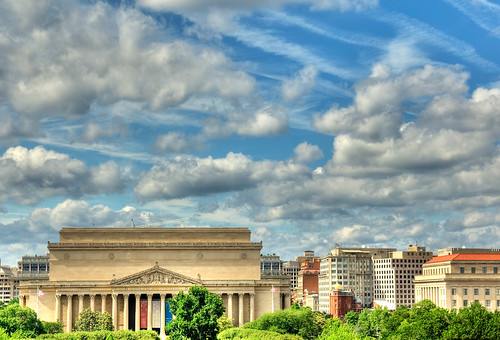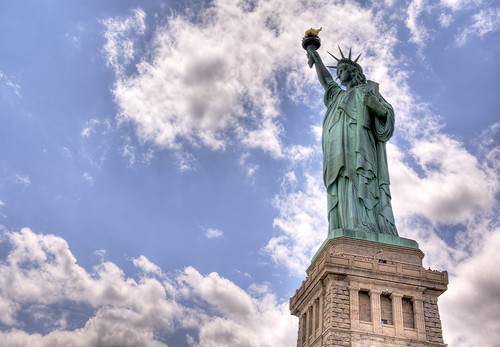HDR
Nathan Myhrvold on the future of digital camera technology. A while back at a wedding, Jeff mentioned to me that he'd returned from a conference at MIT where he'd seen demos of a camera that would take three exposures of every photo, basically automatically bracketing every photo to address exposure problems with scenes of high dynamic range (HDR). That technology hasn't even launched yet, but impatient photographers have leaped ahead with a partial solution, taking multiple exposures manually at different exposures, then blending them in Photoshop CS2 or Photomatix, or both, to create HDR photos. This is despite the fact that HDR displays are too expensive for mass-production.
Having a camera that could bracket shots near simultaneously would solve the issue of trying to handhold for multiple exposures, though you couldn't do it by varying the shutter speed given that you only have one lens. What you'd have to do is have multiple sensors, each with a differing sensitivity. Or you could just have one sensor with a much wider dynamic range. Being able to capture HDR with just one photo would solve the problem with creating HDR pics right now, which is that your subject has to be, for the most part, stationary.
One area where this type of technology would be particularly useful is wedding photography. Trying to capture the brilliant white of a wedding dress and the ebony black of a tuxedo side by side is a photographic challenge. Expose properly for the dress and the groom's tux looks like a solid block of black. Expose for the tux and the bride looks like a face nestled in a blinding explosion of white. Most wedding photographers have switched to shooting digital, and the speed of the digital workflow certainly benefits the photographer. But to my eye, black and white film still does a superior job of capturing the dynamic range of most wedding portraits. If one was to be married this year, I'd recommend asking one of the wedding photographers to shoot medium format film, especially for bride-groom portraits.
I have not played around with HDR much, but last last weekend while in DC visiting my sister I came across some dramatic cloud formations moving with urgency over the Mall. I bracketed a few shots so I could experiment with HDR in Photoshop CS2, clouds being perhaps the most popular element that drives photographers to turn to HDR processing (the texture of clouds disappears when photos are overexposed which is almost always in single exposures since landscapes below tend to be darker). I didn't have a tripod, unfortunately, and so I had to handhold. Not ideal, but I don't enjoy hauling a tripod around when sightseeing.
This one I shot out a window of the Hirshhorn seemed to come out the best, though I still need to play around with the settings in Photoshop and Photomatix to learn how each affects the final output.
Photoshop seems to produce more natural-looking images, while Photomatix can leave you with more saturated and dramatic HDR but also more artificial-looking images. Do a tag search on "HDR" in Flickr (over 25,000 results and rising) and you'll find some truly bizarre-looking HDR photos of images that don't require the effect. The end result often resembles some garish, digitally drawn watercolor.
Here's another one from this past weekend, when I took a visitor out to see The Statue of Liberty.


